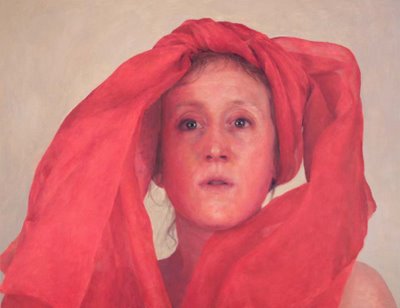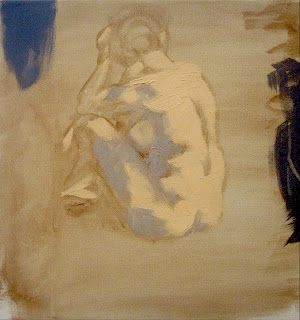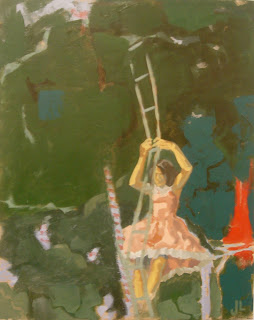oil on canvas, 2010
Wood Clay Paint
This blog is intended to record the various stages in the artistic process of several projects. I work mainly in two areas: painting and sculpture. In this blog entitled "Wood Clay Paint", I will be working out different ideas and sharing images of the process as each project progresses.
Sunday, September 25, 2011
Friday, May 20, 2011
Assignment 4: Reflection
Evaluate and Discuss the Technique and Process:
What decisions throughout your process were risky or bold?
The last painting ("Studio with a Red Chair") was kind of a risk for me and the things I usually paint. I'd actually never made a painting of a figure-less setting before, other than for simple painting exercises in high school. It was a challenge to create an atmosphere and emotion with just color, value, and composition; no human figures or facial expressions to tell the viewer how to feel.
The last painting ("Studio with a Red Chair") was kind of a risk for me and the things I usually paint. I'd actually never made a painting of a figure-less setting before, other than for simple painting exercises in high school. It was a challenge to create an atmosphere and emotion with just color, value, and composition; no human figures or facial expressions to tell the viewer how to feel.
Another risky decision I made earlier in the semester was to work entirely with the pallet knife for one of my paintings:
I'd experimented a little with painting with the pallet knife in previous paintings, but it was mostly only to texturize the setting or background. For this painting, I also painted the figure with the pallet knife. This brought a sort of consistency to the painting that I'd never really accomplished before.
Another risk I took was in my attempt and creating an abstract impressionist sort of setting in "Woman on the Ladder", this didn't work out so well. The reason it was not as successful as other risks I'd taken, I realized later, was that I didn't take enough of a risk. I could have worked more on the trees in the background, adding more and more layers to bring it further into abstraction. I also could have tried to paint the figure in a way that it too takes on the character of abstract expressionism. Not bold enough!
I felt this area was successful:
Areas like this definitely needed more work:
What decisions were safe or unchallenging to your usual way of working?
The decision to paint from photographic references was a pretty safe one, it's much easier to paint all of the proportions and perspective correctly. Also to paint compositions where the main focus is a figure -- it is easier to portray a human feeling in a facial expression, or even a figure's body language, than to successfully portray a human feeling in a figure-less painting (ie. landscape, setting, still life, abstract).
Discuss Material Choices
Why did you choose the materials you used? How did you use the unique qualities inherent to the medium?
I chose to paint with acrylics because they dry fast and therefore enable me to experiment with painting in layers, building up a surface where things are hidden or subtly showing through. Using acrylics allows me to work fast and paint bold-ly, without having to wait for things to dry to take my next steps.
How would the work change if you used a different medium?
Painting with oils, and working wet into wet, I'd be able to push the paint around more, but not layer the paint as well. It's just a different look, and I really love how wet into wet comes out, but I felt for the textural qualities I was interested in for these pieces, that acrylic would work better.
Consider the scale of the work. What aspects of technique or content would be jeopardized, and which would be enhanced if the work was much larger or smaller?
The two larger paintings ("The Lady Rider" and "Studio with a Red Chair"), which were 36" x 36", were sized appropriately. They were large enough to contain the level of detail I wanted while still being able to paint loosely with big strokes, they were also small enough to invite the viewer to come closer to see the detail.
The two smaller paintings "Man/Clown Sleeping" and "Woman on the Ladder", definitely should have been bigger. Although it would have been interesting to keep the figures in those two paintings the same size and just expand their surroundings, so that the focus actually shifts away from the figure.
Discuss Content and Meaning
Use adjectives to describe your approach (relentless, harsh, affectionate, considered, etc.)
Confident, transient, sculpted, self-distructive, careful, muted, layered, thick, blocky,
How does the relationship between the image and the speed or attitude with which it is executed, add content to the work?
For my final painting, "Studio with a Red Chair", the subject concerns the process, as it is an image of the setting in which the artist's process takes place. Here the relationship between the image and the attitude in which it's executed is one of great compatibility. The random splotches of paint in the room (on the floor, easle, chair, etc.) become random splotches of paint on my canvas, and vise versa.
What are the ideas and message you are working through?
I am interested in the labor of love, and the love of labor. How we willingly exhaust ourselves for the things we love and how this affects the way we view our daily routines. The activities that are often perceived as strenuous or mundane are inspiring to me because they are overlooked, yet are often the most memorable. My work addresses these activities in the portrayal of temporary moments and glimpses into people’s private lives -- the moments where people are unaware of the time or space they occupy.
How do you lead us to this message or meaning?
I seek to express the attitudes of the characters or environments I paint in my mark-making and pallet. Color and texture can evoke emotion strongly, sometimes more so than a painted facial expression, and can be interpreted differently by individuals based on their associations. My hope is that my paintings will produce emotions that are associated with nostalgia, mystery, labor, and refuge -- experiences that highly individual but are commonly shared.
Do you leave room for the viewer to form opinions about the subject, or is your work more didactic?
I try to leave room for the viewer to form opinions, usually the images I choose are pretty ambiguous, and could be read several different ways.
What makes your work personal? What techniques have you used that make the process personal?
I work with the underpainting, as opposed to working over it. I allow for the underpainting to come through the painting, like moss that grows between bricks in a wall. The paint never covers the canvas completely, edge-to-edge, and the underpainting also comes through in between objects and figures to separate them and give the feeling of a moment that is temporary: something that is either slowly revealing itself or fading away. My intention for painting this way is to remind the viewer of the labor of the painting process, to impart a sense of my love for this process, and to achieve a sense of transience and mortality.
The "moss between bricks" technique is something I discovered last year -- I didn't think of it as a personal/unique process until other students started pointing out the technique I'd come up with and could recognize my work because of it. I'd like to explore it more, and consider why I paint this way and what I can say about my subjects with this process.
Discuss Context
Which artists are you influenced by and what do you borrow/steal from them?
My greatest influences in painting are Paul Cezanne, Camille Pissarro, Edgar Degas, Gottfried Helnwein, and Andrew Wyeth.
My greatest influences in painting are Paul Cezanne, Camille Pissarro, Edgar Degas, Gottfried Helnwein, and Andrew Wyeth.
Cezanne for his shapes, the way he breaks up giant detailed landscapes into blocks of color.
Pissarro for his texture and his ability to loosely render subtle details.
Degas for his colors, I mix a lot of pastels and muted tones in my work because of my early exposure to Degas as a child.
Helnwein for his technical skill, contextual element of fantasy, and ability to capture the human expression in a way that photographs cannot.
Wyeth for his passion for obsession. Obsessed with light, and the way it falls on his main subject, Helga. I can see the beauty and pain of his obsession in his work.
How do your paintings relate to historical “schools” or “movements” within the last forty years? How do they differ?
My paintings relate to impressionism in terms of the use of light, and expressionism in terms of the brush strokes. My paintings differ from these categories because of the content -- I try to have some sort of message or reason behind the subjects I choose to paint and images I reference, whereas Impressionism applied mainly to the technique, and involved mostly figurative and landscape studies. In most cases with Impressionism, the content was solely in the way the surface was painted.
What current events or circumstances influence your paintings? (pop culture, politics, new media, technology, international events, etc.) What makes your project relevant?
I guess the concepts and events I address are only current because they are timeless -- the work involved in creating art, the ritual, the mind-set; with circus performers, musicians, painters, it's all labor in a sense. Art and labor are always relevant, but they are also constantly changing. They mean different things to different people in different time periods. I'd like to eventually get to a point in my painting where my work is as timeless as my subjects. To produce something that will be accessible for future generations as well.
The 4th & Final Painting: "Studio with a Red Chair"
A painting of the artist's process and its affect on the space.
(Location: Art rooms, SF State University)
THE PROCESS:
Begins with the underpainting:
I begin to paint in what's furthest back in the setting, light pouring into the room, blocking in basic colors and shapes:
Building up the light, basic details:
Adding the shadows:
The fully rendered space:
Now here comes the fun part, painting the splotches of paint on the objects and surfaces in the room:
Voilà!
Thursday, May 19, 2011
Assignment 3: PaintersNYC Criticisms
6/22/2006

"There's a deftness to the paint handling, & a sense of specificity of texture & light that she nails without being too render-y." - brambles
I love the use of the phrase "too render-y" here, I often try to do the same in my work, especially paintings involving portraiture, it is easy to get caught up in rendering details so much that the brush strokes begin to loose their character, and Dubnau definitely pays attention to this. This is a good thing for me to pay attention to; reading this comment made me think about my own intentions when it comes to representation and treatment of the subject through the energy behind the paint. Jenny Dubnau definitely handles her paint delicately, and there's a softness to the way she treats her characters. It's really quite sweet, she paints as though she finds each of her subjects extremely endearing.
"From the paintings I've seen, she manages, with thin layers of paint, to attain an incredible richness and a heightened emotional state." - bigsurprises
This comment points out the concept of creating an emotional state more with the manner or method of using the paint than with the painting's subject itself. I found this comment helpful because it shows the importance of building a sense of meaning in the painting technique and not relying on your subject matter to portray your message.
"i saw this show and didn't get much beyond the quality of the painting, which is very nice, the color, texture, etc. but i don't think she reached far enough(if at all)beyond her reference to make a Painting. it would have worked much better if she simply showed the photographs." - cornflower
This person is clearly focusing only on the mere fact that the artist paints realistically from photographs, and failed to see the differences in the way Dubnau paints versus other realistic painters. This comment taught me that people won't always pay close attention to the subtleties in the handling of the paint. The question is wether it is better to keep those subtleties and ignore comments like this one, or to paint in a way that makes your intention overly obvious to the viewer. I, for one, appreciate Dubnau's soft subtlety.
"And what is the point of the silly costumes? A witch hat on a grown woman? Is a silly costume or expression enough to make a painting interesting? I don't think so. Also, there has to be something in a painting that isn't ugly or dreary. The work is too politely painted (staid) to be bold and brash. It's some tentative place between realism and expressionism.
The paintings are repetitive. I looked her up online and her earliest painting (2000) is the same as these, figure in the center, against a solid color wall, painted the same way. How about a full figure? A location? A different subject? A development in technique?
The artist seems stuck and needs a change.
Question for the crowd: why do artists make the same thing over and over and over? Do they not realize they are doing it?" - josie
This comment was especially useful to me and my current project. Half-way through the semester I began to ask myself: "What is the importance of costumed characters and clowns?" And of course, I personally care about these characters because they were a huge influence in my life, and I wanted to show the transient circus life and the elements of work and devotion involved, but finally realized how the "clown make-up" is a loaded image, and the last thing I wanted was for my experiences to be portrayed as cliche.
Reading this comment, while I don't necessarily agree with this opinion in terms of Dubnau's work, has re-affirmed my decision to move away from circus characters, specifically clown make-up, and re-examine the essence of what I was interested in with my subject. I'm interested in the element of work: the Labor of love, and the love of labor. What the artist goes through for their work, the artist's routine and the impression of their work on the spaces they exist and work in.
I'm leaving the clowns and circus performers, for a while, and focusing on a more universal element. The next place I explore will be the painter's studio, a setting that is full of years of paint drips, dents, marks, cuts -- the artistic process as preserved by the constant inhabitance of the place.
Painting 3: "Woman on the Ladder" (Woman Rigging Trapeze)
The process:
After the finishing the underpainting, I began to develop the setting:
Originally, the composition involved the top of the circus bus,
and the edge of the trees against the sky.
But after having other's ask me what it was, I decided to take it out of the composition completely and have the figure suspended high in the trees.
I tried to deal with the mass of trees in a way that was more abstract than representational, focusing on patterns and overall shapes.
This is the final piece on the wall at critique:
Subscribe to:
Comments (Atom)
















































